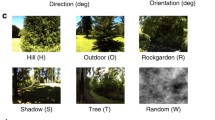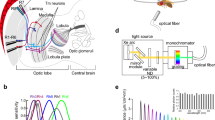Summary
-
1.
The physiology of large monopolar cells (LMCs) in the lamina of the visual system of the droneflyEristalis was investigated by recording the intracellular responses to light flashes, in the presence or absence of intracellularly injected current.
-
2.
In the dark, the steady-state voltage-current relationship is approximately linear for small excursions of membrane potential (Fig. 1). In different recordings LMC dark input resistance ranged from 20 to 45 MΩ.
-
3.
As in other fly species, the intracellular response to a flash of light from a point source consists of a hyperpolarizing transient at ‘light on’, followed by a small, sustained plateau (usually hyperpolarizing), and a depolarizing transient at ‘light off’ (Fig. 2).
-
4.
In some LMC recordings the injection of steady current affects primarily the ‘on’ response, and not the ‘off’ response. The amplitude of the ‘on’ transient is larger in the presence of depolarizing current and smaller in the presence of hyperpolarizing current (Figs. 2, 3), implying a transient decrease of input resistance during the ‘on’ response. Recordings of this nature tend to be associated with comparatively low values of dark input resistance (Fig. 5). In other recordings the injection of steady current affects primarily the ‘off’ response, and not the ‘on’ response. The amplitude of the ‘off’ transient is larger in the presence of hyperpolarizing current, and smaller in the presence of depolarizing current (Fig. 4), implying a transient decrease of input resistance during the ‘off’ response. Recordings of this nature tend to be associated with comparatively high values of dark input resistance (Fig. 5).
-
5.
In comparison with the ‘off’ response, the ‘on’ response is much more labile (Fig. 6). This observation, taken together with the above data, suggests that the ‘on’ and ‘off’ responses of the LMC are generated at independent, spatially-segregated sites.
-
6.
We propose a model of LMC function in which the sites for ‘on’ and ‘off’ response generation are spatially separated. This model accounts for the variability in effectiveness of extrinsic current injection on the ‘on’ and ‘off’ responses. We suggest that in distal penetrations (i.e. near the photoreceptor synapses) injected current affects primarily the ‘on’ response, whereas in proximal (i.e. axonal) penetrations it is the ‘off’ response that is most affected. The range of experimentally determined values of dark input resistance, and their relation to the effect of extrinsic current on the ‘on’ or ‘off’ response (Fig. 5), agrees with the predictions of the model that dark input resistance varies with electrode position along the LMC. Thus, we suggest that low values of input resistance (ca. 20 MΩ) correspond to distal penetrations, and high values (ca. 45 MΩ) correspond to proximal penetrations.
-
7.
In 3 cells, the injection of steady hyperpolariting current led to the occurrence of spontaneous depolarizing events and action potentials in the dark (Figs. 7, 8). In 2 of these cells light increased the frequency of events and action potentials; in another it had the opposite effect. We suggest that the light-evoked response of the LMC under these conditions reflects the combined effect of a hyperpolarizing input at the receptor synapse, and at least one additional, more proximal input driving the depolarizing events and spikes. This is the first report of impulse activity in LMCs, which have hitherto been assumed to encode visual signals in a purely analog fashion.
Similar content being viewed by others
References
Araki T, Otani T (1955) Response of single motoneurons to direct stimulation in toad's spinal cord. J Neurophysiol 18:472–485
Autrum H, Zettler F, Järvilehto M (1970) Postsynaptic potentials from a single monopolar neuron of the ganglion opticum 1 of the blowflyCalliphora. Z Vergl Physiol 70:414–424
Baylor DA, Fuortes MGF (1970) Electrical responses of single cones in the retina of the turtle. J Physiol 207:77–92
DeVoe RD (1985) The eye: electrical activity. In: Kerkut GA, Gilbert LI (eds.) Comprehensive insect physiology, biochemistry and pharmacology. Pergamon Press, Oxford, pp 277–354
Dubs A (1982) The spatial integration of signals in the retina and lamina of the fly under different conditions of luminance. J Comp Physiol 146:321–343
Frank K, Fuortes MGF (1956) Stimulation of spinal motoneurones with intracellular electrodes. J Physiol 134:451–470
Goodman LJ, Mobbs PG, Guy RG (1977) Information processing along the course of a visual interneuron. Experientia 33:748–750
Guy RG, Goodman LJ, Mobbs PG (1979) Visual interneurons in the bee brain: Synaptic organization and transmission by graded potentials. J Comp Physiol 134:253–264
Hateren JH van (1986) An efficient algorithm for cable theory, applied to blowfly photoreceptor cells and LMC's. Biol Cybern 54:301–311
Hengstenberg R (1977) Spike responses of ‘non-spiking’ visual interneurone. Nature (Lond) 270:338–340
Jack JJB, Noble D, Tsien RW (1975) Electric current flow in excitable cells. Chapter 7: Mathematical models of the nerve cell. Clarendon Press, Oxford, pp 131–224
Kuffler SW (1953) Discharge patterns and functional organization of mammalian retina. J Neurophysiol 16:37–68
Laughlin SB (1973) Neural integration in the first optic neuropile of dragonflies: I. Signal amplification in darkadapted second-order neurons. J Comp Physiol 84:335–355
Laughlin SB (1974a) Resistance change associated with the response of insect monopolar neurons. Z Naturforsch 29c:449–450
Laughlin SB (1974b) Neural integration in the first optic neuropile of dragonflies. III. The transfer of angular information. J Comp Physiol 92:377–396
Laughlin SB (1981) Neural principles in the visual system. In: Autrum H (ed) Vision in invertebrates (Handbook of sensory physiology, vol 7/6B). Springer, Berlin Heidelberg New York, pp 133–280
Laughlin SB (1984) The roles of parallel channels in early visual processing by the arthropod compound eye. In: Ali MA (ed) Photoreception and vision in invertebrates. Plenum Press, New York, pp 457–481
Laughlin SB, Hardie RC (1978) Common strategies for light adaptation in the peripheral visual systems of fly and dragonfly. J Comp Physiol 128:319–340
Milde J (1981) Graded potentials and action potentials in the large ocellar neurons of the bee. J Comp Physiol 143:427–434
Shaw SR (1968) Organization of the locust retina. Symp Zool Soc Lond 23:135–163
Shaw SR (1972) Decrementai conduction of the visual signal in barnacle lateral eye. J Physiol 220:145–175
Shaw SR (1979) Signal transmission by graded slow potentials in the arthropod peripheral visual system. In: Schmitt FO, Worden FG (eds) The neurosciences: fourth study program. MIT Press, Cambridge, Mass, pp 275–295
Shaw SR (1984) Early visual processing in insects. J Exp Biol 112:225–251
Simmons P (1982) Transmission mediated with and without spikes at connexions between large second-order neurons of locust ocelli. J Comp Physiol 147:401–414
Spencer WA, Kandel ER (1961) Electrophysiology of hippocampal neurons. III. Firing levels and time constants. J Neurophysiol 24:260–271
Strausfeld NJ (1970) Golgi studies on insects. Part II: The optic lobes of Diptera. Phil Trans R Soc Lond B258:135–223
Strausfeld NJ, Campos-Ortega JA (1977) Vision in insects: pathways possibly underlying neural adaptation and lateral inhibition. Science 195:894–897
Strausfeld NJ, Nässel DR (1980) Neuroarchitecture of brain regions that subserve the compound eyes of Crustacea and insects. In: Autrum H (ed) Vision in invertebrates (Handbook of sensory phyiology, vol 7/6B). Springer, Berlin Heidelberg New York, pp 1–133
Wilson M (1978) Generation of graded potential signals in the second order cells of locust ocellus. J Comp Physiol 124:317–331
Zeltler F, Autrum H (1975) Chromatic properties of lateral inhibition in the eye of a fly. J Comp Physiol 97:181–188
Zettler F, Järvilehto M (1971) Decrement-free conduction of graded potentials along the axon of a monopolar neuron. Z Vergl Physiol 75:402–421
Zettler F, Järvilehto M (1972) Lateral inhibition in an insect eye. Z Vergl Physiol 76:233–244
Zettler F, Järvilehto M (1973) Active and passive axonal propagation of non-spike signals in the retina ofCalliphora. JComp Physiol 85:89–104
Zettler F, Weiler R (1976) Neuronal processing in the first optic neuropile of the compound eye of the fly. In: Zettler F, Weiler R (eds) Neural principles in vision. Springer, Berlin Heidelberg New York, pp 227–237
Zimmerman (1978) Field potential analysis and the physiology of second-order neurons in the visual system of the fly. J Comp Physiol 126:297–316
Author information
Authors and Affiliations
Rights and permissions
About this article
Cite this article
Guy, R.G., Srinivasan, M.V. Integrative properties of second-order visual neurons: a study of large monopolar cells in the droneflyEristalis . J. Comp. Physiol. 162, 317–331 (1988). https://doi.org/10.1007/BF00606120
Accepted:
Issue Date:
DOI: https://doi.org/10.1007/BF00606120




